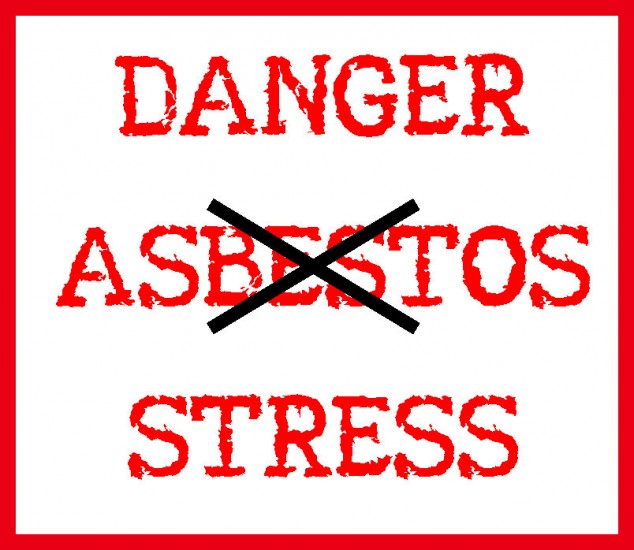According to a research brief completed by Rand Corporation, “Approximately 730,000 people have filed claims for asbestos injuries in the United States through 2002. At least 8,400 defendants and insurers have paid $70 billion to settle these claims.”
That is less than 1 million claims and a 70 billion price tag.
About 100 companies have filed for bankruptcy because of their asbestos exposure.(1)
Why were companies held liable for asbestos? They knew the risk to employees (or should have because the risk was known) and they did not provide adequate protection for their workers. Rand states it this way, “Asbestos litigation, the longest-running mass tort litigation in the United States, arose as a result of individuals’ exposure to asbestos and the failure of many product manufacturers to protect their workers.”(2)
The risk to your organization from not protecting your employees from workplace stress could bankrupt your company.
It does not matter who you are, or how big you are because the pool of potential litigants expands as your workforce expands. Some of the more conservative estimates I’ve seen estimate that 26% of the population has unhealthy stress levels and that 70% of that is due to workplace stress. Let’s do the math.
314,000,000 x .26 = 81,640,000 x .7 = 57,480,000
People in USA x low estimate of those with unhealthy stress levels = 81.6 million
70% attributed to workplace stress brings the number down to 57.4 million
That equates to more than 78 times the number of asbestos litigants.
And, unlike asbestos, risk cannot be stopped by no longer using the product. Workplace stress risk will continue as long as the business is in business. The best you can do it mitigate it. The good news is our program takes stress management a giant step forward.
Pay Attention: Think Long-Term
The research is compelling. TRUE Prevention–Optimum Health: Remember Galileo touches upon many of the stress related illnesses including heart disease which accounts for 1/3 of all deaths. In early 2015, Stress Kills:Happiness Heals will tell the full story–not just the health impacts, but the social problems exacerbated by stress, including divorces, depression, and suicides.
If the potential of corporate liability due to workplace stress that employers know, or should know, are harmful to their employees mental and physical well-being does not make you afraid you need to talk to a risk manager. The potential threat is real. Once the research is clear and compelling, businesses are held to a standard that they should know the risks of placing demands on their employees that lead to chronic stress.
Putting your head in the sand and ignoring the issue will not make it go away. But there are ways to manage the risk without doubling your workforce.
Stress management skills are not taught in school. The vast majority of your employees have no idea how to lower the stress they feel in any given situation. You already know some of them handle stress better than others, but not why.
The stress reduction techniques touted by most of the books and stress management teachers are dose dependent and stressed people are less likely to actually do them. It is not the reason they are stressed, stress decreases motivation. It is part of the problem. It is also part of your engagement problem. Employees who understood how to manage stress might find their environment challenging instead of stressful.
Face it, we cannot eliminate the stress from every job. Performing surgery is stressful, caring for a preterm infant with serious complications is stressful, regulations that increase and change frequently is stressful, taking up the slack from disengaged co-workers is stressful. Eliminating stress is not an option.
The connection between workplace stress and health is irrefutable. Already, in some large cities like New York and Los Angeles, police officers who die from heart disease–even if they are on vacation when they die–are considered work-related deaths. But stress does not have to involve real life or death situations for the human body to experience the negative health effects.
Long-Term May Mean… Tomorrow
The number of asbestos claims is a drop of water in the ocean compared to the potential stress claims from employees. The future that I’m talking about is not that far in the future. To those who are familiar with the state of the research connecting stress to mental and physical illnesses, it is already clearly visible. When will the first case be filed? It could be tomorrow. The evidence is compelling enough and accumulating on an almost daily basis.
What can you do to manage this risk?
The economics will not allow you to double your workforce to reduce the workload, so that is not an option.
Dose dependent stress management techniques like exercise, helping others, going outside,meditation, massage, yoga, and tai chi are dose dependent and the evidence that those suffering from the highest levels of stress are least likely to do them. The fact that they are not doing them is not a defense because evidence demonstrating that it is the high stress that makes it less likely just points the finger back at the cause of the stress.
There is a way to teach employees to manage the stress at the root cause that empowers them to perceive the stressful situation in less stressful ways. Why is this the best method? Because it addresses the issue at the root cause, it affects the entire experience. It shows the employee they have more control over their stress than they know. Increasing employee’s locus of control in this way has multiple benefits including improved health and engagement. That’s three boxes checked in one program.
- Reduce risk of stress-related litigation
- Improve Employee Wellness Efforts
- Increase Employee Engagement
But the benefits do not end there. The program delivers considerably more. Relationships between co-workers (and their relationships outside work) improve because of what they learn in the program. This not only makes the workplace more harmonious, it lessens the amount of outside relationship stress that is adversely affecting the work day. This is not just romantic relationships, but also relationships with children, parents, and friends.
How much does relationship drama impact your organization’s productivity? How much of management’s time is spent dealing with personality conflict type issues?
There is another benefit. From years in risk management, I am well aware that some lawsuits employers have to defend against are for things that one employee interprets as threatening but another one would not even remember a few days later. It is the perception of the event, rather than the actual event, that creates the problem. Our programs provides employees with skills that enable them to perceive situations from perspectives that feel better to them. While it is never possible to quantify lawsuits avoided (a bane of compliance officers and risk managers everywhere), the dots can be connected and the relationship can be clear enough that the CFO will understand the benefits.
Let’s return to the wellness program for a minute. All those healthy habits you’re attempting to get your employees to do are hindered by high stress. In fact, the link between high stress and obesity has changed the paradigm of calories in – calories out = BMI. Stress affects how the body processes the food a person eats and increases the risk of obesity, which increases the risk of diabetes, which increases the risk of heart disease. Stress also increases the risk of high blood pressure which increases the risk of heart disease and stroke. Chronic stress also diminishes the effectiveness of the immune function, increasing the risk of colds, flu, and even cancer. All of this is already scientifically documented. Many of the citations are in TRUE Prevention–Optimum Health, but Stress Kills:Happiness Heals, which is in the editing stage expands the picture further.
Other Benefits
The benefits of our program seem too good to be true but the reason they are so expansive is because they address the root cause. Almost everything else that is done to improve health and stress today addresses symptoms, not the root cause. Now is the time to take action. There are other benefits from our program detailed throughout our website.
Take Action…Today
If this sounds frightening, it is. What can you control? Can you control the job responsibilities in a way that makes them not stressful? Can you control the work loads employees are tackling?
What you can do is empower them with skill based training that insulates them from much of the stress in their lives–both work-related and personal. This training would go a long way toward demonstrating that you took every possible precaution to help your employees. Of course, it should be combined with other things you’re probably already doing, such as an EAP program. But when you wait for the situation to be at the point where most employees will reach out to an EAP, the stress has already caused damage.
We measure a variety of things in a host of different ways before and after the training, including stress, depression (expect about 10% of your employees to be suffering from depression in the pre-training testing), resilience, and emotional intelligence. You can choose to add other measures. The program is provided in large groups so the cost is surprisingly affordable. Smaller employers can combine to form a larger group to keep their costs reasonable. In large organizations, we have train the trainor programs.
Contact us today, sleep better tonight.
(1) http://www.crowell.com/files/List-of-Asbestos-Bankruptcy-Cases-Chronological-Order.pdf
(2) http://www.rand.org/pubs/research_briefs/RB9155/index1.html

